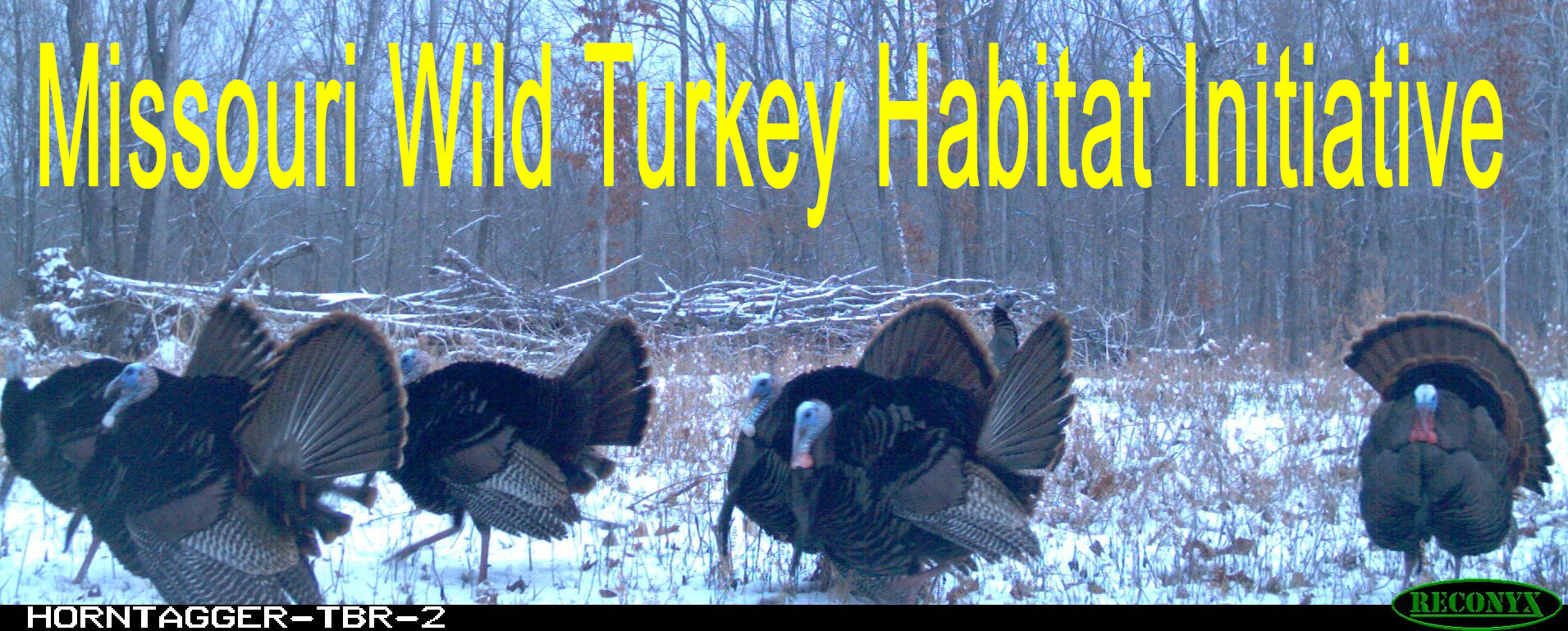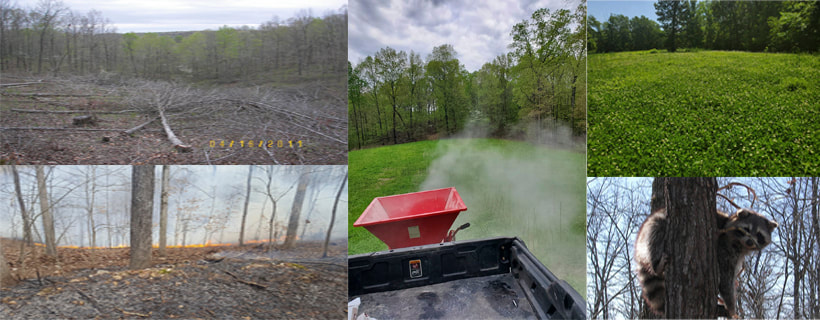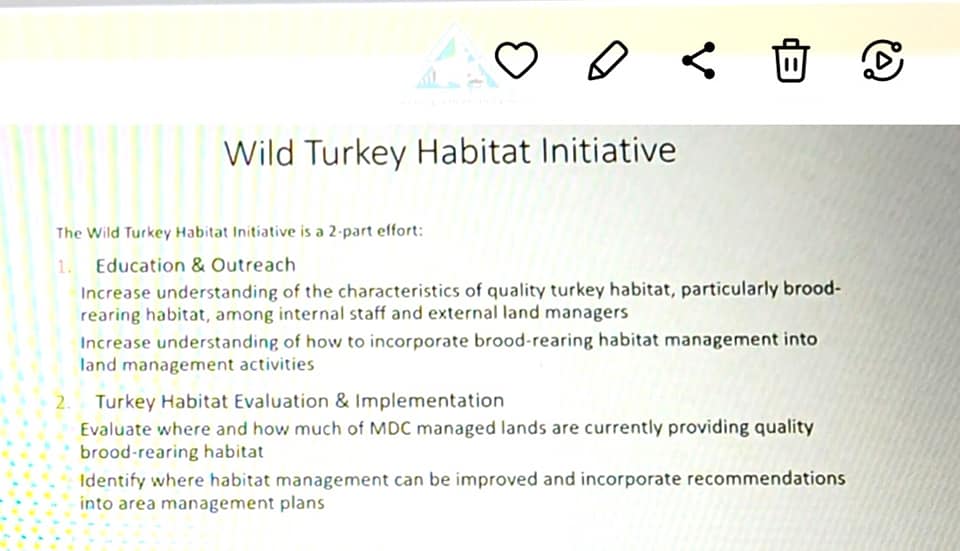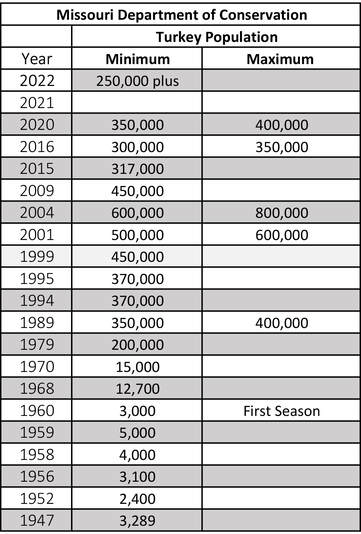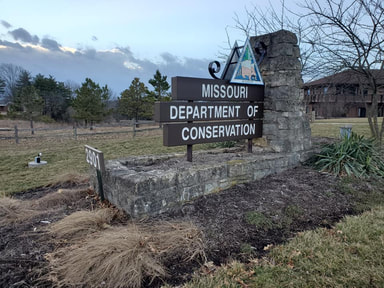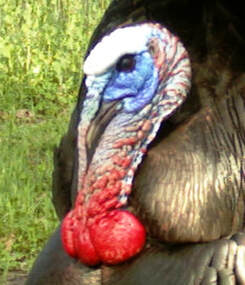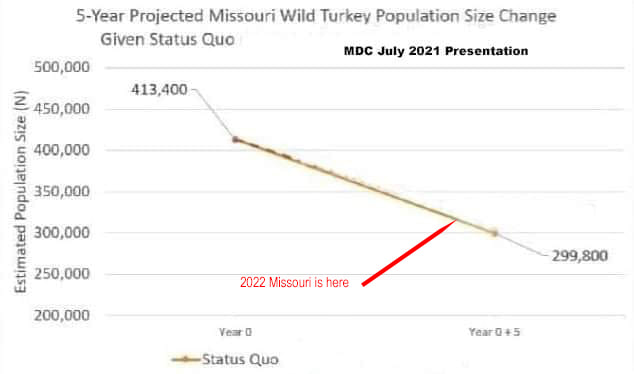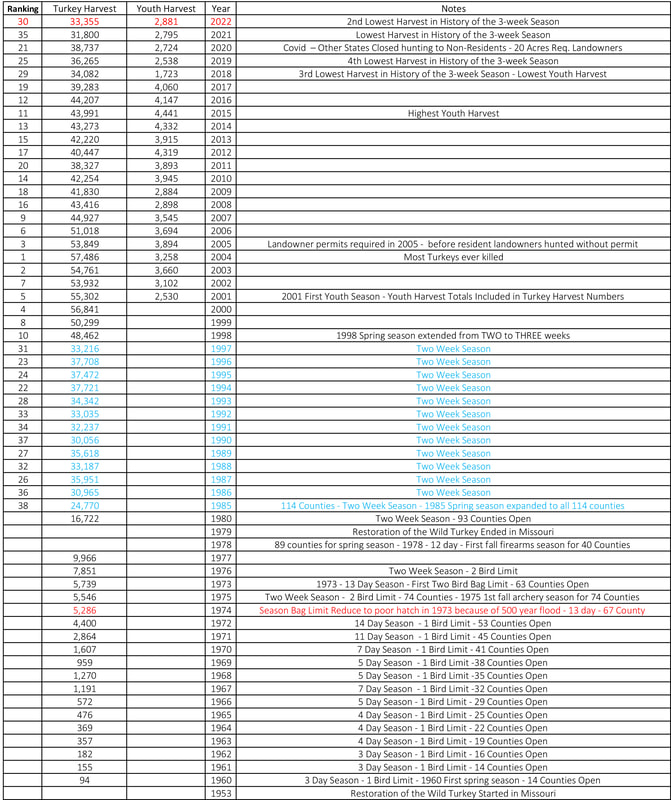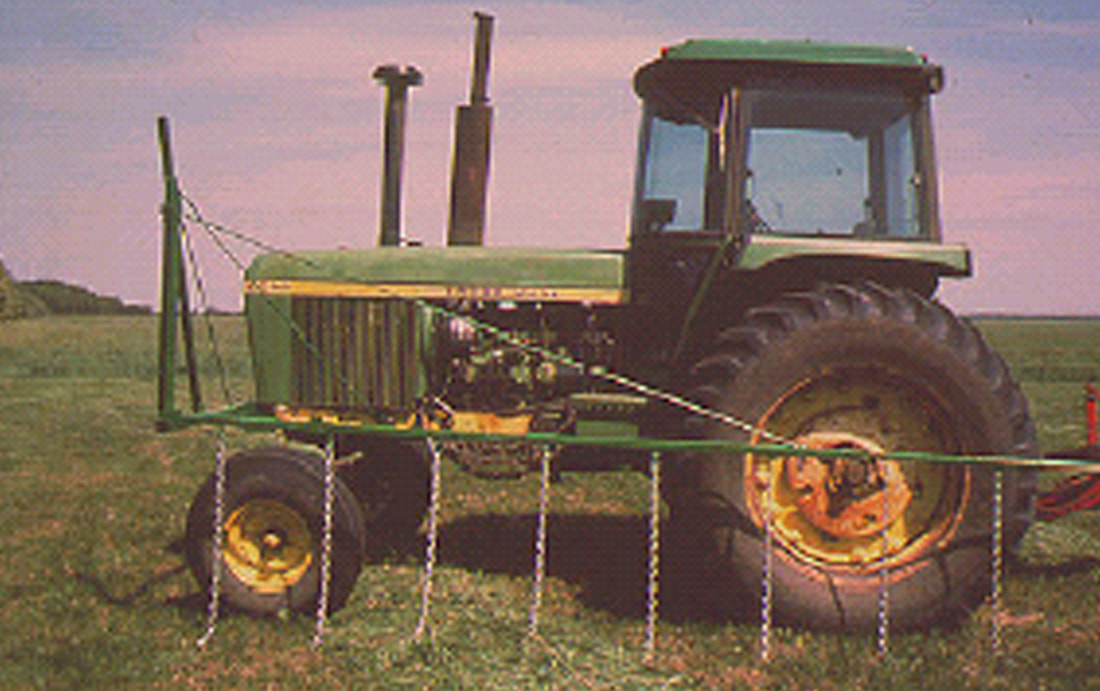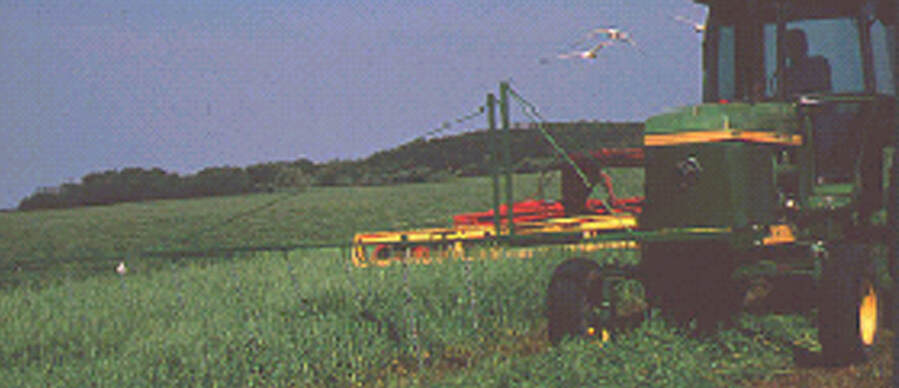Missouri Wild Turkey Habitat Initiative
LAND MANAGEMENT PRACTICES COST PER ACRE
You control what you can and let go of what you can’t. We can manage habitat and predation to a degree. Research shows weather being a big factor in survival for quail chicks and turkey poults - Can’t control that, but we can manage other things. Just common sense.
Cost estimates are very site/project specific and have ranges of low to high in price. Price of fuel or equipment in any given year. But this will give insight into the cost.
Land Management is disposable income don't let anyone lie to you! It cost money for private landowners, hunters and trappers to manage for wildlife and they should be appreciated for what they do!
Cost of Timber Stand Improvement
Timber Stand Improvement cost an average of $75.00 per acre for our forest inclusive of all costs for labor and herbicide.
Source – Conservation Federation of Missouri – Dave Murphy
Cost of Prescribed Burning
The cost of burning can vary widely due to factors such as burn unit size, availability of prescribed fire crews (e.g. consultants), as well as terrain and vegetation types. Small burn units can be much more expensive due to fixed costs and other factors. In the southeastern U.S., where prescribed fire is a common management practice, the average cost is about $32/acre. In Pennsylvania, the per-acre cost of burning is highly variable and can be as high as $400/acre or more, particularly for small burn units.
Source: Pennsylvania State Extension
USDA Missouri state average cost list notes $22.00/ac for grassland habitat types and $65.00/ac for woodland habitat types. Assume these are the costs that factor in the time value of the crew members.
We unaware of an extensive data set for the actual cost of prescribed burning on private land in Missouri. Actual costs may vary in relation to who is prepping and/or conducting the burn. The landowner may do all the work themselves with a volunteer crew and could be a relatively low cost or they may hire a contractor which would elevate the cost
Source: Missouri Prescribed Fire Council
$26.00/ac to $28.00/ac for Grassland and $75.00/ac to $119.46/ac for Woodland
Source: USDA-Natural Resources Conservation Service
Example: Originally the National Park Service had five prescribed burn units totaling 903 acres in the Thorny Creek area. Cooperation with the Missouri Department of Conservation consolidated these five units into one and increased the unit to 2,232 acres. This expansion greatly increased operational safety and efficiency by expanding the perimeter of the unit to the Current River and an existing road system. It also dramatically affected the financial efficiency of the project compared to previous years, reducing the average cost from $79.00 per acre to $5.00 per acre.
Cost of Food Plots
Establishing a food plot can cost up to $200 an acre in seed, herbicide, fertilizer and lime.
Source – University of Missouri Extensions
Cost of Trapping
Trapping is broken into two categories start up and annual cost. This cost was mostly determined by the cost of an individual trap and therefore varied based on trap type purchased. The average price range of box traps was $60–80 and footholds were between $10–30.
The annual average trapping cost on surveyed properties was $2.93 per acre.
The average start up cost $3.93 cost per acre.
Source – Tall Timbers Research Report
GROUND NEST PREDATORS
If you have 1 ounce care of the conservation about Wild Turkey or Quail then read the unbiased report.
Read the whole thing. Just highlighted parts that Missouri so called experts say is a lie.
Here some great information you won't read from Missouri Biologist or Missouri NWTF Biologist.
https://talltimbers.org/.../11/QC_2019_FINAL_Reduced.pdf
Missouri Wild Turkey Habitat Initiative coming in 2024
The ONLY solution the Missouri Department of Conservation has to offer the Missouri Landowners and Hunters for the Wild Turkey Decline.
Wild Turkey Habitat Initiative.
Missouri Conservation Commission May 2022 Meeting Tentative Agenda Items
Friday, May 20, 8 a.m. - REGULAR OPEN MEETING
Presentation: Wild Turkey -- Reina Tyl, Scientist
BS degree in 2015.
Masters in 2019.
MDC hired the Wild Turkey Biologist in 2019 after the previous Wild Turkey Biologist Jason Isabelle
Also in multiple other interviews.
The current wild turkey biologist did not grow up hunting, had never Turkey hunted till 2021 in Missouri and did not kill a bird.
I am told that the Wild Turkey Biologist did kill bird in 2022.
Both Missouri Wild Turkey Biologist have watched the largest wild turkey decline in Missouri history.
NOW a 3rd Missouri Wild Turkey Biologist is being looked for as the 2nd one is leaving.
Not asking you to spend you money to join a consevation group, the majority of conservation in groups in Missouri NO LONGER have your back, matter of fact save your money for habitat and traps for YOURSELF, not asking you to buy a t-shirt and I will donate money to a research project.
I am NO LONGER asking you the Missouri Citizens, Hunters, Landowners, Conservationist to take your time and write the Missouri Conservation Commission that is a waste of time and effort for the past 10 years on predators and 5 years on Wild Turkey I have found.
The only thing necessary for the triump of evil is for people to do nothing. That's exactly what has happened in Missouri. It has become explotation over conservation.
The Missouri Conservation Commission previous members and current members, have sat back and watched the largest wild turkey decline in Missouri history.
William L. (Barry) Orscheln is the Chairman, Mark L. McHenry, Dr. Steven D. Harrison and Margaret F. (Margy) Eckelkamp
Missouri Conservation Commission May 2022 Meeting Tentative Agenda Items
Friday, May 20, 8 a.m. - REGULAR OPEN MEETING
Presentation: Wild Turkey -- Reina Tyl, Scientist
MISSOURI WILD TURKEY TASK FORCE
Did you know that Missouri Department of Conservation NOW has a MISSOURI WILD TURKEY TASK FORCE?
Exacatly who sits on this MDC Missouri Wild Turkey Task Force?
This MDC - Missouri Wild Turkey Task Forces is also forming a MDC WORKING GROUP to come up with the Missouri Wild Turkey Habitat Initative or the public and private lands.
May 25, 2022
When was the Missouri Wild Turkey Task Force form?
Missouri Department of Conservation Reply: The Wild Turkey Task Force (TTF) has existed in some form since the late 1990s.
So let me get this straight, I am to believe that in 32 years of conservation magazines, radio and T.V. interviews, website information, press releases, seminars, webinars, Facebook post, conservation commission meetings, letters to the public, and conversation with mdc staff and MDC turkey research publications and the Missouri NWTF etc., etc., – Not one time in 22 years, till the May of 2022 has this ever been mentioned before!
I heard of the Missouri Feral Hogs Task in 2008 more times than I care to count, that’s only 14 years.
Since 2001 - Nothing has changed with turkey regulations - So the TTF just had coffee and donuts for past 21 years.
Ok I take your word for it. LMAO!
What is the Mission of the Wild Turkey Task Force?
Missouri Department of Conservation Reply: The TTF serves as an advisory committee to the Turkey Program, led by staff in the Science Branch, regarding turkey regulations and management issues. The TTF is guided by the Mission of the Turkey Program (outlined in the Wild Turkey Management Plan) which “uses science-based methods, including public engagement, to manage wild turkey populations throughout Missouri that will provide quality hunting and other recreational opportunities.”
How many people are on the Missouri Wild Turkey Task Force?
Missouri Department of Conservation Reply: There have been several iterations of the group structure and membership over the years, but currently the group has 9 core members. The TTF is Chaired by the Turkey Program Leader (MDC’s Turkey Biologist) and all Department Branches with a voting role on the Regulations Committee are represented on the TTF:
Communications (1 member),
Community and Private Lands Conservation (1 member),
Education (1 member), Protection (1 member),
Regional Resource Management (2 members – North Representative; NW, NE, KC, CE Regions & South Representative; SW, OZ, SE, STL Regions),
Relevancy (1 member),
Statewide Resource Management (1 member).
Is the entire Missouri Wild Turkey Task Force MDC staff?
Missouri Department of Conservation Reply: Yes
What titles do the members of the Missouri Wild Turkey Task Force hold with the department of conservation?
Missouri Department of Conservation Reply:
Wild Turkey and Ruffed Grouse Biologist,
Private Lands Programs Supervisor,
Hunter Education & Shooting Range Coordinator,
Protection Field Chief,
Regional Resource Management Supervisor,
Private Land Conservationist II,
Hunter & Angler Marketing Specialist,
Wildlife Section Chief,
Regulation Booklet Editor.
Wild Turkeys have been research in Missouri since the 1950’s.
Reinventing the wheel. Wild Turkey Management information has been around a long time, 30 years of Wild Turkey Management in print, hate to dig anymore out.
1st Annual National Wild Turkey Symposium - 1959 - Missouri Research
2nd Annual National Wild Turkey Symposium - 1970 - Missouri Research
3rd Annual National Wild Turkey Symposium - 1975 - Missouri Research
4th Annual National Wild Turkey Symposium - 1980 - Missouri Research
6th Annual National Wild Turkey Symposium - 1990 - Missouri Research
7th Annual National Wild Turkey Symposium - 1995 - Missouri Research
8th Annual National Wild Turkey Symposium - 2000 - Missouri Research
9th Annual National Wild Turkey Symposium - 2005 - Missouri Research
That's all been preach by Game and Fish Departments and NWTF for past 30 years.
Heaven forbids anyone invents the internet!
So, in 2024. Government employee is going to come to your land and tell you how to improve your brood and nesting habitat and provide information online. WOW.
What has the Missouri Department of Conservation and the NWTF been doing for past 22 years.
In Missouri since the year 2000, the Missouri Department of Conservation started the Private Land Conservationist in which the job was to help the 300,000 landowners with wildlife management along with the National Wild Turkey Federation Employees in Missouri - District Biologist, Project Biologist, Project Forester, NFI Forester to help landowners with wild turkey management.
You can't make this up. The Commission is excited with this NEW Project.
Good luck to you Missouri Landowners you must be living under a rock for the past 30 years. The 2022 season was the first season in 32 years I did not turkey hunt because the population is so low in my area only 1 hen as appeared in the last 6 months.
But wait! What happened to the Missouri Wild Turkey Research Result coming in 2026!
MISSOURI WILD TURKEY RESEARCH
THE SOLUTION IN 2026 & BEYOND – MDC Wild Turkey Biologist “Once these questions are answered, we’ll be able to mitigate the challenges by MANIPULTAING HABITAT to improve nest success and poult survival. This information would inform habitat management efforts on public and private lands in Missouri to increase turkey recruitment and ultimately abundance.”
So the solution is Habitat ONLY and in 2026 guess we are not waiting and going to deploy in 2024 – They will be telling MISSOURI LANDOWNER how to manipulating habitat to improve nest success and poult survival. This information would inform habitat management efforts on public and private lands in Missouri to increase turkey recruitment and ultimately abundance.”
RECOMMENDATION BY THE MDC in 2021 in letters to public.
“Because turkey abundance is driven by production, the best way to increase turkey numbers in your area is by providing the habitat turkey needs to nest successfully and raise their young. Planting native warm-season grasses and wildflowers, prescribed burning, edge feathering, timber stand improvement, creating forest openings and woodland restoration, are some of the best ways to improve nesting and brood rearing habitat.”
For the year 2000 - Note from the past Father of Wild Turkey Restoration in Missouri – MDC Biologist Vangilder - MANAGEMENT IMPLICATIONS - Nowhere is there an area in north Missouri of (15,000 ac) that is 70% timbered. Corn and soybean fields more than make up for the lack of trees and turkey densities in the northern part of the state are much higher than in the more heavily forested parts of south Missouri.
Average reproductive rates were much lower in the eastern Ozarks than in northern Missouri and do not appear to be sufficient to maintain population levels observed at the beginning of the study.
Biologists are sometimes forced to use data obtained from short-term, localized studies to model populations on large geographic areas. Often, the results obtained during these modeling efforts do not reflect actual changes in the population.
These types of problems are evident when comparing similar research between northern and southern Missouri. Obviously, average reproductive potential differs substantially between the 2 regions. Southern Missouri has a lower reproductive rate.
Missouri Wild Turkey Habitat Initiative
DO NOT let them blame YOU! I know more people practicing Wild Management TODAY than I did 20 years ago and even 10 years ago. If they are the EXPERTS – Every property they manage – Public Lands in Missouri would be a Wild Turkey MECCA – It is NOT!
FREE TO ALL
LANDOWNERS / HUNTERS AND CONSERVATIONIST
Material by be dated but habitat management for Wild Turkey has existed for the past 30 plus years. DO NOT let them tell you they are just coming out with it.
WILD TURKEY BULLETIN use to be readily available for years.
These are the ones I had on hand.
Wild Turkey Bulletin No. 1
| easternwildturkey.pdf | |
| File Size: | 185 kb |
| File Type: | |
Wild Turkey Bulletin No. 9
| plantinglegumes.pdf | |
| File Size: | 287 kb |
| File Type: | |
Wild Turkey Bulletin No. 13
| bulletin_13.pdf | |
| File Size: | 395 kb |
| File Type: | |
Wild Turkey Bulletin No. 15
| managingfortimberandwildlifediversity.pdf | |
| File Size: | 382 kb |
| File Type: | |
Wild Turkey Bulletin No. 16
| predatorswildturkeys.pdf | |
| File Size: | 376 kb |
| File Type: | |
Wild Turkey Bulletin No. 17
| managingstreamsidezones.pdf | |
| File Size: | 444 kb |
| File Type: | |
Wild Turkey Bulletin No. 19
| rights-of-way.pdf | |
| File Size: | 338 kb |
| File Type: | |
Wild Turkey Bulletin No. 23
| roadswildlife.pdf | |
| File Size: | 345 kb |
| File Type: | |
